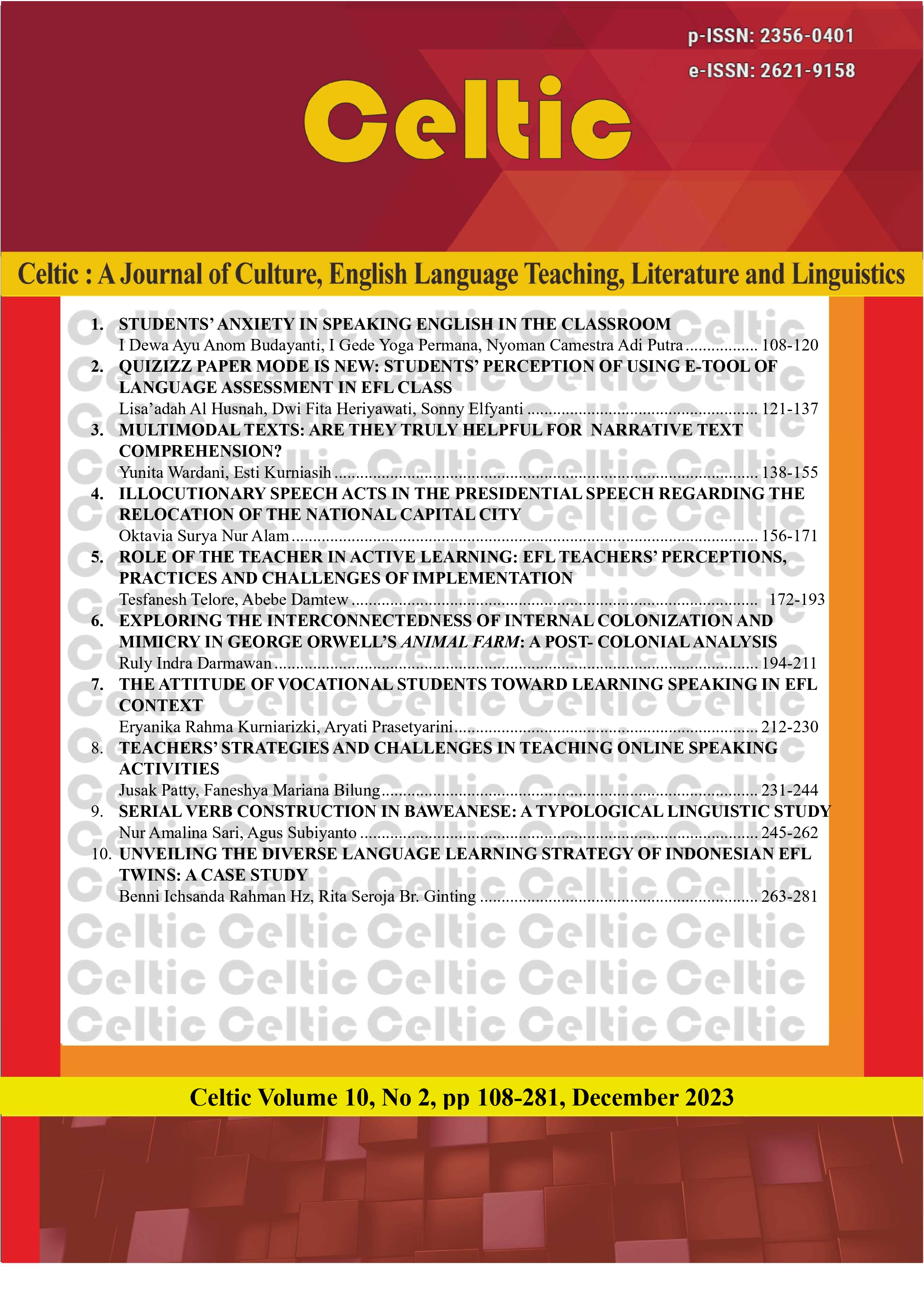UNVEILING THE DIVERSE LANGUAGE LEARNING STRATEGY OF INDONESIAN EFL TWINS: A CASE STUDY
DOI:
https://doi.org/10.22219/celtic.v10i2.28802Abstract
Each individual possesses a distinct essence that sets them apart, even in the case of identical twins. In language acquisition, learners’ personality type has emerged as one of the most determining constructions for students’ learning strategy. Through a phenomenological case study, intricate interplay between personality types and language learning strategies of two Indonesian identical twin girls studying English language education were investigated, supported by one triangulator participant. By employing the Oxford (1990) Strategy Inventory for Language Learning and the MBTI test, the researchers gathered the extensive data on their language learning strategy distinctions and personality differences. The results indicate that despite sharing the same upbringing, their diverse personalities - one an ENFJ and the other an ENTJ - have contributed to vastly different cognitive, memorization, compensation, metacognitive, social learning, and affective learning approaches. The findings provide intriguing insights into the intricacies of language acquisition and highlight the significance of individual differences in shaping the learning styles.
Downloads
References
Baxter, P., & Jack, S. (2008). Qualitative case study methodology: Study design and implementation for novice researchers. The Qualitative Report, 13(4), 544–559.
Boroujeni, A. A. J., Roohani, A., & Hasanimanesh, A. (2015). The impact of extroversion and introversion personality types on EFL learners’ writing ability. Theory and Practice in Language Studies, 5(1), 212. https://doi.org/10.17507/tpls.0501.29
Cohen, A. (1998). Strategies in Learning and Using a Second Language. Longman.
Cohen, A. D. (2011). Strategies in learning and using a second language. Harlow, England. Pearson/Longman.
Creswell, J. W., & Poth, C. N. (2016). Qualitative inquiry and research design: Choosing among five approaches. Sage publications.
Cruickshank, D. ., Jenkins, D. ., & Metcalf, K. . (2003). The Act of Teaching. 3rd ed. McGraw-Hill.
Fadaee, E., Marzban, A., & Najafi Karimi, S. (2021). The relationship between autonomy, second language teaching styles, and personality traits: A case study of Iranian EFL teachers. Cogent Education, 8(1), 1881203. https://doi.org/10.1080/2331186x.2021.1881203
Fazeli, S. H. (2011). The Exploring Nature of Language Learning Strategies (LLSs) and Their Relationship with Various Variables with Focus on Personality Traits in the Current Studies of Second/Foreign Language Learning. Online Submission, 1(10), 1311–1320. https://doi.org/10.4304/tpls.1.10.1311-1320
Fewell, N. (2010). Language learning strategies and English language proficiency: An investigation of Japanese EFL university students. Tesol Journal, 2(1), 159–174.
Foroozandehfar, L., & Khalili, G. F. (2019). On the relationship between Iranian EFL learners’ reading fluency, their personality types and learning styles. Cogent Arts & Humanities, 6(1), 1681347. https://doi.org/10.1080/23311983.2019.1681347
Gao, X. (2007). Language learning experiences and learning strategy research: Voices of a mainland Chinese student in Hong Kong. International Journal of Innovation in Language Learning and Teaching, 1(2), 193–207. https://doi.org/10.2167/illt011.0
Gardner, R. C. (1985). Social psychology and second language learning: The role of attitudes and motivation. (No Title).
Ghani, M. (2003). Language learning strategies employed by L2 learners. Journal of Research (Faculty of Languages & Islamic Studies), 4, 31–36.
Griffiths, C. (2003). Patterns of language learning strategy use. System, 31(3), 367–383. https://doi.org/10.1016/s0346-251x(03)00048-4
Haradasht, P. N., & Baradaran, A. (2013). The Comparative Effect of Top-down Processing and Bottom-up Processing through TBLT on Extrovert and Introvert EFL. International Journal of Applied Linguistics and English Literature, 2(5), 229–240. https://doi.org/10.7575/aiac.ijalel.v.2n.5p.229
Hsiao, T., & Oxford, R. L. (2002). Comparing theories of language learning strategies: A confirmatory factor analysis. The Modern Language Journal, 86(3), 368–383. https://doi.org/10.1111/1540-4781.00155
Johnson, W. L., Mauzey, E., Johnson, A. M., Murphy, S. D., & Zimmerman, K. J. (2001). A higher order analysis of the factor structure of the Myers-Briggs Type Indicator. Measurement and Evaluation in Counseling and Development, 34(2), 96–108. https://doi.org/10.1080/07481756.2001.12069026
Joy, S., & Kolb, D. A. (2009). Are there cultural differences in learning style? International Journal of Intercultural Relations, 33(1), 69–85. https://doi.org/10.1016/j.ijintrel.2008.11.002
Kormos, J., & Csizer, K. (2014). The interaction of motivation, self‐regulatory strategies, and autonomous learning behavior in different learner groups. Tesol Quarterly, 48(2), 275–299. https://doi.org/10.1002/tesq.129
Lai, Y.-L. (2005). Teaching vocabulary learning strategies: Awareness, beliefs, and practices. A survey of Taiwanese EFL senior high school teachers. Unpublished Master’s Thesis, University of Essex, England.
Larsen, R. ., & Buss, D. . (2018). Personality psychology: Domains of knowledge about human nature (6th ed.). McGraw-Hill.
Lave, J., & Wenger, E. (1991). Situated learning: Legitimate peripheral participation. Cambridge university press.
Macaro, E. (2006). Strategies for language learning and for language use: Revising the theoretical framework. The Modern Language Journal, 90(3), 320–337. https://doi.org/10.1111/j.1540-4781.2006.00425.x
Masgoret, A., & Gardner, R. C. (2003). Attitudes, motivation, and second language learning: A meta‐analysis of studies conducted by Gardner and associates. Language Learning, 53(S1), 167–210. https://doi.org/10.1111/1467-9922.00227
Masruddin, M. M., & Pratiwi, H. H. (2016). STUDENTS’PERCEPTION AND THEIR ATTITUDE TOWARDS ENGLISH TEACHERS’PERSONALITY. Langkawi: Journal of The Association for Arabic and English, 2(2), 202–218. https://dx.doi.org/10.31332/lkw.v2i2.463
Matthews, G., Zeidner, M., & Roberts, R. D. (2006). Models of Personality and Affect for Education: A Review and Synthesis. https://doi.org/10.4324/9780203874790.ch8
Mayer, J. D. (2017). Personality: A systems approach. Rowman & Littlefield.
Miyake, A., & Friedman, N. P. (1998). Individual differences in second language proficiency: Working memory as language aptitude. Foreign Language Learning: Psycholinguistic Studies on Training and Retention, 339–364.
Myers Briggs, I., McCaulley, M. ., Quenk, N. ., & Hammer, A. . (1998). A guide to the development and use of the Myers-Briggs Type Indicator. Consulting Psychologists Press.
Myers, I. B., McCaulley, M. H., & Most, R. (1985). Manual: A guide to the development and use of the Myers-Briggs Type Indicator. (No Title).
Myers, I. B., & Myers, P. B. (1995). Gifts Differing: Understanding Personality. USA Davies-Black Publishing, 215.
O’malley, J. M., O’Malley, M. J., & Chamot, A. U. (1990). Learning strategies in second language acquisition. Cambridge university press.
Oxford, R. (1990). Language learning strategies: What every teacher should know. Heinle & heinle Publishers.;
Oxford, R. L. (2011). Teaching and researching language learning strategies. Harlow. Pearson Education. https://doi.org/10.4324/9781315838816
Oxford, R., & Burry-Stock, JA (1995). Assessing the Use of Language Learning Strategies Worldwide with the ESL/EFL Version of the Strategy Inventory for Language Learning (SILL). The System, 23(1), 1–23. https://doi.org/10.1016/0346-251x(94)00047-a
Oxford, R. L., Griffiths, C., Longhini, A., Cohen, A. D., Macaro, E., & Harris, V. (2014). Experts’ personal metaphors and similes about language learning strategies. System, 43, 11–29. https://doi.org/10.1016/j.system.2014.01.001
Oxford, R., & Nyikos, M. (1989). Variables affecting choice of language learning strategies by university students. The Modern Language Journal, 73(3), 291–300. https://doi.org/10.1111/j.1540-4781.1989.tb06367.x
Palfreyman, D. (2003). Expanding the Discourse on Learner Development: A Reply to Anita Wendon. Applied Linguistics, 24(2), 243–248. https://doi.org/10.1093/applin/24.2.243
Pervin, L. A., & John, O. P. (1997). Personality: Theory and research.
Platsidou, M., Kantaridou, Z., & Papadopoulou, I. (2017). International orientation as predictor of EFL learning strategy use in adolescent students. Language, Culture and Curriculum, 30(2), 157–173. https://doi.org/10.1080/07908318.2016.1236127
Pyke, K. (2005). “Generational Deserters” and “Black Sheep” Acculturative Differences Among Siblings in Asian Immigrant Families. Journal of Family Issues, 26(4), 491–517. https://doi.org/10.1177/0192513x04273578
Quenk, N. L. (2009). Essentials of Myers-Briggs type indicator assessment. John Wiley & Sons.
Redjeki, G. P. D., & Hapsari, A. (2022). EFL UNDERGRADUATE STUDENTS’ONLINE SELF-REGULATED LEARNING STRATEGIES DURING COVID-19 PANDEMIC. Celtic: A Journal of Culture, English Language Teaching, Literature and Linguistics, 9(1), 82–96. https://doi.org/10.22219/celtic.v9i1.21066
Rigney, J. W. (1978). Learning strategies: A theoretical perspective. Learning Strategies, 165–205. https://doi.org/10.1016/B978-0-12-526650-5.50012-5
Rubin, J. (1987). Learner strategies: Theoretical assumptions, research history and typology. Learner Strategies in Language Learning, 15, 29.
Seran, Y., & Nalenan, J. S. (2022). ENGLISH GRAMMATICAL COMPETENCE OF AMONDUS IN SECOND LANGUAGE ACQUISITION. Celtic: A Journal of Culture, English Language Teaching, Literature and Linguistics, 9(2), 149–163. Doi: 10.22219/celtic.v9i2.20965
Stern, H. H., & Allen, J. P. B. (1992). Issues and options in language teaching. Oxford University Press, USA.
Stevens, G., & Ishizawa, H. (2007). Variation among siblings in the use of a non–English language. Journal of Family Issues, 28(8), 1008–1025. https://doi.org/10.1177/0192513x07301433
Sulaiman, S., & Sulaiman, T. (2010). Enhancing Language Teaching and Learning by Keeping Individual Differences in Perspective. International Education Studies, 3(2), 134–142. https://doi.org/10.5539/ies.v3n2p134
Thorne, S. L. (2005). Epistemology, politics, and ethics in sociocultural theory. The Modern Language Journal, 89(3), 393–409. https://doi.org/10.1111/j.1540-4781.2005.00313.x
Vann, R. J., & Abraham, R. G. (1990). Strategies of unsuccessful language learners. TESOL Quarterly, 24(2), 177–198. https://doi.org/10.2307/3586898
VanPatten, B., Keating, G. D., & Wulff, S. (2020). Theories in second language acquisition: An introduction. Routledge.
Warn, T. S. (2009). Students’ learning style and their academic achievement for Taxation course–A comparison study. 2nd International Conference of Teaching and Learning. Retrieved from Https://My. Laureate. Net/Faculty.
Watson‐Gegeo, K. A. (2004). Mind, language, and epistemology: Toward a language socialization paradigm for SLA. The Modern Language Journal, 88(3), 331–350. https://doi.org/10.1111/j.0026-7902.2004.00233.x
Wenger, E. (1998). Communities of practice: learning, meaning, and identity. New York: Cambridge University.
Downloads
Published
How to Cite
Issue
Section
License
Copyright (c) 2023 Benni Ichsanda Rahman Hz, Rita Seroja Br. Ginting

This work is licensed under a Creative Commons Attribution-ShareAlike 4.0 International License.
- Authors retain copyright to publish without restrictions and grant the journal right of first publication with the work simultaneously licensed under a Creative Commons Attribution License that allows others to share the work with an acknowledgement of the work's authorship and initial publication in this journal.
- Authors are able to enter into separate, additional contractual arrangements for the non-exclusive distribution of the journal's published version of the work (e.g., post it to an institutional repository or publish it in a book), with an acknowledgement of its initial publication in this journal.
- Authors are permitted and encouraged to post their work online (e.g., in institutional repositories or on their website) prior to and during the submission process, as it can lead to productive exchanges, as well as earlier and greater citation of published work.














